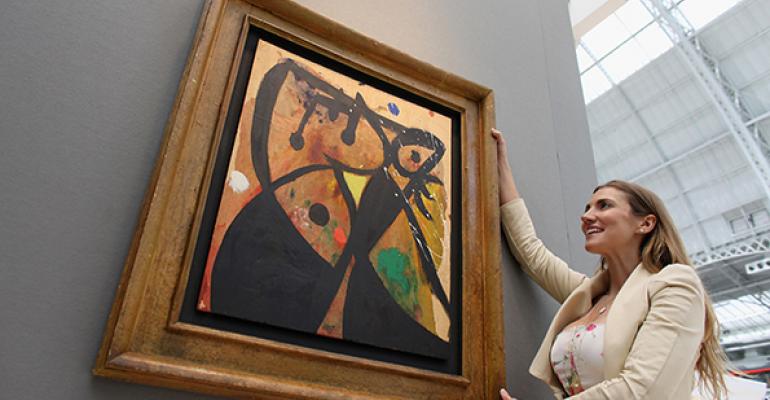A panel of museum directors, curators, art scholars and dealers helps the Internal Revenue Service value artwork gifts. At stake are income tax deductions for charitable donors and gift and estate taxes for gifts to family members and other non-charities.
The panel reviews artworks valued at $50,000 or more. If the panel rejects a taxpayer’s appraisal, it may suggest a different value, get additional information or consult a specialist. The panel provides advice and makes recommendations to the Art Appraisal Services (AAS) unit in the Office of Appeals for the IRS.
In Fiscal Year 2018 (the latest report), AAS adopted 69% of the panel’s recommendations. The panel’s specialty areas include paintings and sculpture, decorative arts and antiques. The panel currently has two subcommittees: the Fine Arts Panel, which reviews paintings, sculpture, watercolors, prints and drawings; and the Decorative Arts Panel, which reviews items such as antique furniture, decorative art, ceramics, textiles, carpets and silver.
How the Panel Operates
AAS takes steps to ensure objectivity and taxpayer privacy. Information provided to the panelists doesn’t include the taxpayer’s name, the type of tax, the tax consequences of any adjustments to the value or who did the appraisal. To minimize the possibility that panelists recognize a taxpayer’s entire collection, the art works are usually discussed in alphabetical order by artist or, in the case of decorative art, by object type. If there’s a conflict of interest with a panelist and a work of art under review, the panelist doesn’t participate in the discussion and is excused from that portion of the meeting.
Before panel meetings, AAS appraisers send photographs and written materials to the panelists about the works of art under review. The materials include information from the taxpayer’s appraisal, such as size, medium, physical condition, provenance, any comparable sales, appraised value and the AAS appraiser’s own research, including available information on public and private sales of relevant artwork.
During the panel meetings, the panelists review the information provided, along with the research and findings of both the panelists and AAS appraisers. After discussing each item individually, the panel reaches consensus on the value of a subject work. Panel discussions are lively and serious. Despite the different perspectives of dealers, museum curators and scholars, substantial disagreements are rare. When disagreements happen, they generally result from insufficient information. In those cases, the panelists may recommend additional research, such as inspecting the property or consulting with additional experts, before making a recommendation as to value. Once the AAS appraiser completes the additional work, the item may be brought up for review at a subsequent panel meeting.
The panel’s recommendations are strictly advisory. The AAS staff reviews all the panel's recommendations, which become the position of the IRS only with AAS concurrence.
2018 Report (the Latest)
The panel reviewed 251 items with an aggregate taxpayer valuation of $360,866,084 on 67 taxpayer cases. The average claimed value for an item reviewed by the panel was $1,437,713.
The panel recommended accepting the value of 94 items or 37% of the items presented. It adjusted 157 items or 63% of the appraisals it reviewed. On the 157 items adjusted, the panel recommended total net adjustments of $(64,621,787) to the appraised values, an 18% decrease.
The panel reconsidered 10 items originally valued at $7.15 million by the taxpayers and $12,398,000 by the panel. After reviewing the additional information, the panel revised the original recommendation to $12,273,000 ($125,000 decrease). The items reconsidered weren’t included in the information above or that follows.
Binding Valuation Agreement
By paying a user fee, a donor of a work of art appraised at $50,000 or more can get a Statement of Value (SOV) from the IRS that establishes the value of art gifts for income, gift and estate tax purposes. Taxpayers may obtain an SOV from the IRS for an advance review of art valuation claims prior to filing the return. The SOV may then be used to complete the taxpayer's return. The donor must request the SOV after making the gift, but before filing a tax return claiming the charitable deduction. The fee is $7,500 for a SOV for one to three items, plus $400 for each additional item. See Revenue Procedure 2020-1, Appendix A (Jan. 2, 2020); Rev. Proc. 96-15.
User fees for SOV requests made pursuant to Rev. Proc. 96-15 must be made by direct debit from a checking or savings account through the Pay.gov website. Payment confirmations are provided through the Pay.gov portal and should be submitted with the SOV request. AAS won’t consider an SOV request complete, and will hold the request in suspense, until the correct user fee is paid through the Pay.gov website. Use of the Pay.gov website replaces the mailing or hand delivering of user fees. The use of the Pay.gov website to submit SOV user fees is mandatory.
Send requests to: Internal Revenue Service/Art Appraisal Services, 1111 Constitution Avenue, Suite 700, C:AP:SO:ART, Washington, DC 20224-0002, ATTN: AAS.
Note from IRS. It’s recommended that a private delivery service be used, as packages sent via USPS are subject to irradiation which may damage professional photographs.
© Conrad Teitell 2020. This is not intended as legal, tax, financial or other advice. So check with your adviser on how the rules apply to you.





